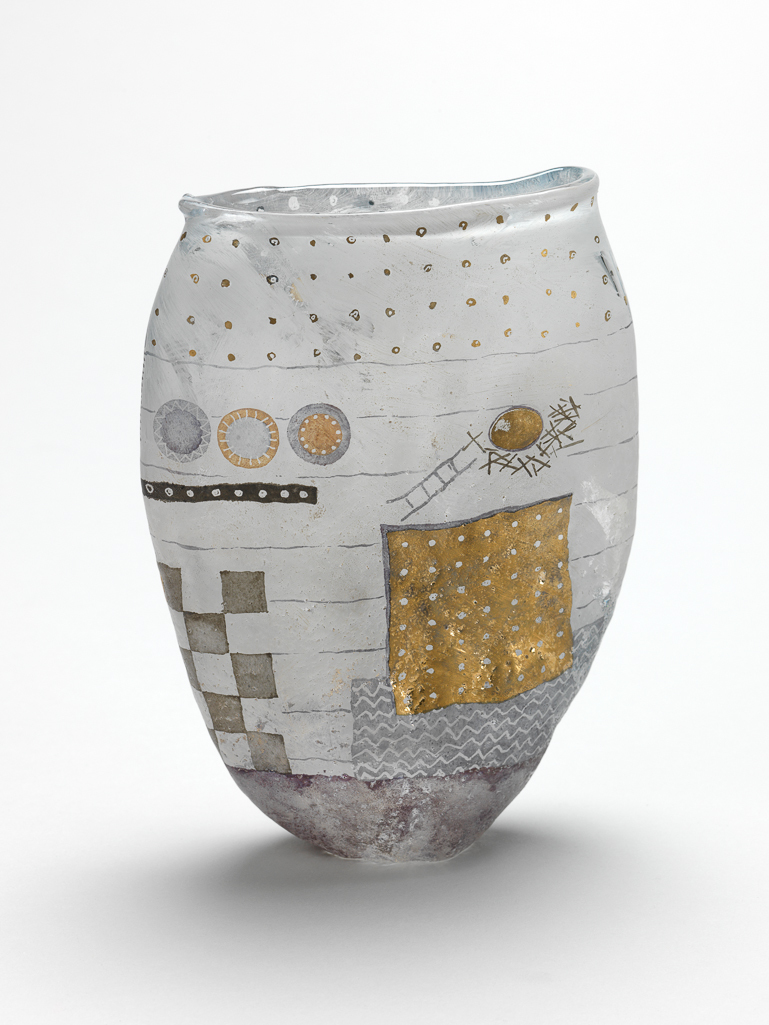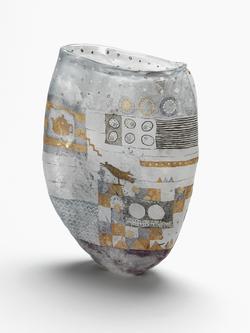Current Location: In storage
Titles
Tea and the Indian Bird
Maker(s)
Glassmaker:
Lowe, Liz
Entities
Categories
Description
Clear glass, blown into a soft sand mould, sandblasted, hand-painted in white, pale purple, and grey enamels and lustres. The vase is of squashed elongated oval form, standing on a narrow irregularly shaped four-sided base. The left side bulges outwards more than the right. On the front there is a teapot in a square border with a zig-zag line extending downwards from it towards a bird, who stands on a chequered form which rises out of waves. Above are six half eggs on a rectangle and above them, three circular dishes. On the other side there is a spotted gold square rising out of waves, with above, a ladder, a ball and ? nails, and to the left three circular dishes over a black bar with white spots. Round the top there are four rows of spots.
Notes
History note: Purchased from the Crafts Council Shop, Victoria and Albert Museum, London
Legal notes
Given by Nicholas and Judith Goodison through the National Art Collections Fund
Measurements and weight
Height: 15.1 cm
Width: 11 cm
Acquisition and important dates
Method of acquisition: Given
(1997-12-05)
by
Goodison, Nicholas and Judith
Dating
20th Century, Late
Elizabeth II
Production date:
AD 1997
Note
Text from object entry in A. Game (2016) ‘Contemporary British Crafts: The Goodison Gift to the Fitzwilliam Museum’. London: Philip Wilson Publishers: Liz Lowe studied Ceramics and Glass at Leicester Polytechnic and the Royal College of Art, London. Surface patterns are often inspired by textiles and are created through painting directly onto the glass surfaces with enamels and lustres. Areas of the surface are sandblasted to create opaque, matt elements through which the shadows of the marks on each side emerge to blend with the foreground marks.
School or Style
studio glass
Contemporary Craft
Components of the work
Decoration
composed of
enamels
( white, pale purple, and grey)
gold
Parts
composed of
glass
Techniques used in production
Mould-blowing
: Clear glass, blown into a soft sand mould, sandblasted, hand-painted in white, pale purple, and grey enamels and gold
References and bibliographic entries
Related exhibitions
Identification numbers
Accession number: C.98-1997
Primary reference Number: 27245
Stable URI
Audit data
Created: Saturday 6 August 2011
Updated: Monday 29 April 2024
Last processed: Thursday 14 August 2025
Associated departments & institutions
Owner or interested party:
The Fitzwilliam Museum
Associated department:
Applied Arts





